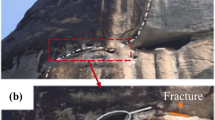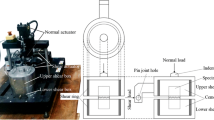Abstract
En-echelon fractures widely exist in natural rock masses. Although the formation and occurrence features of en-echelon fractures have been extensively studied by geologists, the anisotropic mechanical behavior caused by en-echelon fractures has received little attention. In this study, a set of idealized en-echelon fractures were prefabricated and subjected to direct shear tests. The influence of structural parameters (e.g., fracture angle and persistency) of en-echelon fractures on shear strength, friction and dilation behavior, shear failure structures, and acoustic emission response was comprehensively evaluated. The test results show that the shear of en-echelon fractures involves a cracking stage and a shear-slipping stage. These two stages can be quantitatively described by three shear strength indices and three dilation indices, which present varying degrees of anisotropy under different shear stages and boundary conditions. Also, various types of failure structures evolved from en-echelon fractures can be observed. They essentially depend on different crack types and coalescence patterns of rock bridges and greatly affect the friction and dilation characteristics in the shear-slipping stage. Based on the test results, the anisotropic micro-cracking mechanism was first discussed, and then an idealized vertical slope analysis was performed. Finally, some implications were discussed for the fault structures in field and the deep fault behavior.





















Similar content being viewed by others
Abbreviations
- i :
-
Fracture angle
- L r :
-
Rock bridge length
- L j :
-
Fracture length
- k j :
-
Persistency
- T j :
-
Thickness of fault zone
- τ :
-
Shear stress
- σ n :
-
Normal stress
- δ h :
-
Shear displacement
- δ v :
-
Normal displacement
- SR:
-
Shear resistance (stress)
- SR1:
-
The first stress peak
- SR2:
-
The second stress peak
- SRr:
-
The residual stress
- ND1:
-
Dilation at SR1
- NDr:
-
Dilation at SRr
- v d :
-
Dilation rate at SR2
- i d :
-
Dilation angle at SR2
- φ j :
-
Friction angle
- φ w :
-
Wing crack angle
- K 1, K 2 :
-
Stress intensity factor of mode-I, mode-II
- K 1c :
-
Critical mode-I stress intensity factor
- σ c :
-
Normal stress on the crack surface
- τ c :
-
Shear stress on the crack surface
- a :
-
Half of the fracture length, Lj/2
- H :
-
Slope height
- θ :
-
Fault plane angle
- L AC :
-
Fault plane length
- W :
-
Slope weight
- F s :
-
Shear component of slope weight
- F n :
-
Normal component of slope weight
- f s :
-
Safety factor of slope
- f s(SR1):
-
Safety factor calculated from SR1
- f s(SR2):
-
Safety factor calculated from SR2
- f s(SRr):
-
Safety factor calculated from SRr
- φ e :
-
Equivalent internal friction angle
- c e :
-
Equivalent cohesion
- θ cri :
-
Critical failure plane angle
- θ cri(SR1):
-
θcri calculated from SR1
- θ cri(SR2):
-
θcri calculated from SR2
- θ cri(SRr):
-
θcri calculated from SRr
- k n :
-
Normal stiffness
- ∆δ h :
-
Displacement interval
- AE:
-
Acoustic emission
- CNL:
-
Constant normal load
- CNS:
-
Constant normal stiffness
References
Acosta M, Violay M (2020) Mechanical and hydraulic transport properties of transverse-isotropic Gneiss deformed under deep reservoir stress and pressure conditions. Int J Rock Mech Min Sci 130:104235
Ashby MF, Sammis CG (1990) The damage mechanics of brittle solids in compression. Pure Appl Geophys 133(3):489–521
Atkinson BK (1987) Introduction to fracture mechanics and its geophysical applications. Fracture Mechanics of Rock. Academic Press, London, pp 1–26
Bobet A (2000) The initiation of secondary cracks in compression. Eng Fract Mech 66(2):187–219
Brideau MA, Yan M, Stead D (2009) The role of tectonic damage and brittle rock fracture in the development of large rock slope failures. Geomorphology 103(1):30–49
Butler RWH, Spencer S, Griffiths HM (1997) Transcurrent fault activity on the Dead Sea Transform in Lebanon and its implications for plate tectonics and seismic hazard. J Geol Soc Lond 154:757–760
Cheng Y, Wong LNY, Zou C (2015) Experimental study on the formation of faults from en-echelon fractures in Carrara Marble. Eng Geol 195:312–326
Chinnery MA (1966) Secondary faulting: II. Geological aspects. Can J Earth Sci 3:175–190
Erdogan F, Sih GC (1963) On the crack extension in plates under plane loading and transverse shear. J Basic Eng 85(4):519–525
Germanovich LN, Salganik RL, Dyskin AV, Lee KK (1994) Mechanisms of brittle fracture of rock with pre-existing cracks in compression. Pure Appl Geophys 143(1):117–149
Gerolymatou E, Triantafyllidis T (2016) Shearing of materials with intermittent joints. Rock Mech Rock Eng 49(7):2689–2700
Granier T (1985) Origin, damping, and pattern of development of faults in granite. Tectonics 4:721–737
Gross D, Seelig T (2006) Fracture mechanics with an introduction to micromechanics. Springer, Berlin
Huang D, Cen D, Ma G, Huang R (2015) Step-path failure of rock slopes with intermittent joints. Landslides 12(5):911–926
Indraratna B, Haque A (1997) Experimental study of shear behavior of rock joints under constant normal stiffness conditions. Int J Rock Mech Min Sci 34(3–4):141.e1-141.e14
Jiang Y, Xiao J, Tanabashi Y, Mizokami T (2004) Development of an automated servo-controlled direct shear apparatus applying a constant normal stiffness condition. Int J Rock Mech Min Sci 41(2):275–286
Kachanov M (1994) Elastic solids with many cracks and related problems. Adv Appl Mech 30:259–445
Kim YS, Andrews JR, Sanderson DJ (2000) Damage zones around strike-slip fault systems and strike-slip fault evolution, Crackington Haven, southwest England. Geosci J 4(2):53–72
Kim YS, Peacock DCP, Sanderson DJ (2003) Mesoscale strike-slip faults and damage zones at Marsalforn, Gozo Island, Malta. J Struct Geol 25:793–812
Kim YS, Peacock DCP, Sanderson DJ (2004) Fault damage zones. J Struct Geol 26:503–517
Knauss W (1970) An observation of crack propagation in anti-plane shear. Int J Fract 6:183–187
Lajtai E, Carter B, Duncan E (1994) En echelon crack-arrays in potash salt rock. Rock Mech Rock Eng 27:89–111
Martel SJ, Boger WA (1998) Geometry and mechanics of secondary fracturing around small three-dimensional faults in granitic rock. J Geophys Res 103:21299–21314
McGrath AG, Davison I (1995) Damage zone geometry around fault tips. J Struct Geol 17:1011–1024
Myers R, Aydin A (2004) The evolution of faults formed by shearing across joint zones in sandstone. J Struct Geol 26(5):947–966
Nasseri MHB, Rao KS, Ramamurthy T (2003) Anisotropic strength and deformational behavior of Himalayan schists. Int J Rock Mech Min Sci 40(1):3–23
Paris PC, Sih GC (1965) Stress analysis of cracks. Fracture toughness testing and its applications. American Society for Testing and Materials, West Conshohocken, pp 30–83
Patton FD (1966) Multiple modes of shear failure in rock. In: Proceedings of the 1th International Society for Rock Mechanics, ISRM, Lisbon, 1:509–513
Peacock DCP, Anderson MW (2012) The scaling of pull-aparts and implications for fluid flow in areas with strike-slip faults. J Pet Geol 35(4):389–399
Peacock DCP, Sanderson DJ (1995) Pull-aparts, shear fractures and pressure solution. Tectonophysics 241:1–13
Peng S, Johnson AM (1972) Crack growth and faulting in cylindrical specimens of chelmsford granite. Int J Rock Mech Min Sci Geomech Abstr 9:37–86
Petit JP, Barquins M (1988) Can natural faults propagate under mode II conditions? Tectonics 7:1243–1256
Rawling GC, Baud P, Wong TF (2002) Dilatancy, brittle strength, and anisotropy of foliated rocks: experimental deformation and micromechanical modeling. J Geophys Res Solid Earth 107(B10):ETG 8-1-ETG 8-14
Sagong M, Bobet A (2002) Coalescence of multiple flaws in a rock-model material in uniaxial compression. Int J Rock Mech Min Sci 39(2):229–241
Sarfarazi V, Ghazvinian A, Schubert W, Blumel M, Nejati HR (2014) Numerical simulation of the process of fracture of echelon rock joints. Rock Mech Rock Eng 47(4):1355–1371
Savilahti T, Nordlund E, Stephansson O (1990) Shear box testing and modeling of joint bridge. In: Proceedings of international symposium on shear box testing and modeling of joint bridge Rock Joints, Loen, Norway, pp 295–300
Sih GC (1973) Some basic problems in fracture mechanics and new concepts. Eng Fract Mech 5(2):365–377
Tchalenko JS, Ambraseys NN (1970) Structural analysis of the Dasht-e Bayaz (Iran) earthquake fractures. Geol Soc Am Bull 81:41–60
Wong LNY, Einstein HH (2009) Systematic evaluation of cracking behavior in specimens containing single flaws under uniaxial compression. Int J Rock Mech Min Sci 46(2):239–249
Wong RHC, Leung WL, Wang SW (2001) Shear strength study on rock-like models containing arrayed open joints. In: Proceedings of the 38th U.S. rock mechanics symposium, Washington, D.C. pp 843–849
Zhang Y, Jiang Y, Asahina D, Wang C (2020a) Experimental and numerical investigation on shear failure behavior of rock-like samples containing multiple non-persistent joints. Rock Mech Rock Eng 53(10):4717–4744
Zhang Y, Jiang Y, Asahina D, Wang Z (2020b) Shear behavior and acoustic emission characteristics of en-echelon joints under constant normal stiffness conditions. Theor Appl Fract Mech 109:102772
Zhuang X, Chun J, Zhu H (2014) A comparative study on unfilled and filled crack propagation for rock-like brittle material. Theor Appl Fract Mech 72:110–120
Acknowledgements
A part of this research project has been conducted as the regulatory supporting research funded by the Secretariat of Nuclear Regulation Authority (Secretariat of NRA), Japan. The first author is funded by the China Scholarship Council (CSC.201806420027).
Author information
Authors and Affiliations
Corresponding author
Ethics declarations
Conflict of interest
The authors declare that they have no conflicts of interest.
Additional information
Publisher's Note
Springer Nature remains neutral with regard to jurisdictional claims in published maps and institutional affiliations.
Supplementary Information
Below is the link to the electronic supplementary material.
Rights and permissions
About this article
Cite this article
Zhang, Y., Jiang, Y., Asahina, D. et al. Structural Effect of En-echelon Fractures on Shear Behavior of Rock Mass Under Constant Normal Load Conditions: An Experimental Study. Rock Mech Rock Eng 54, 4825–4849 (2021). https://doi.org/10.1007/s00603-021-02555-3
Received:
Accepted:
Published:
Issue Date:
DOI: https://doi.org/10.1007/s00603-021-02555-3




